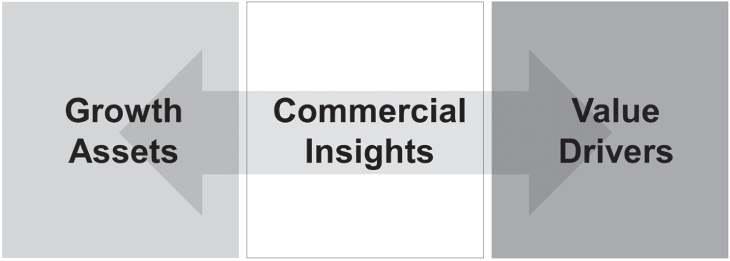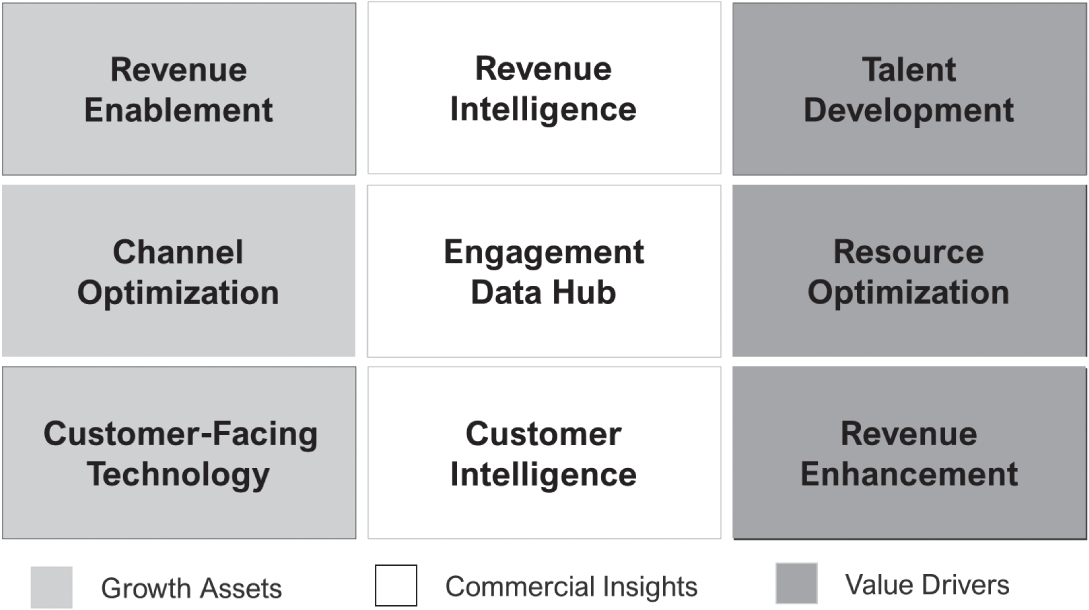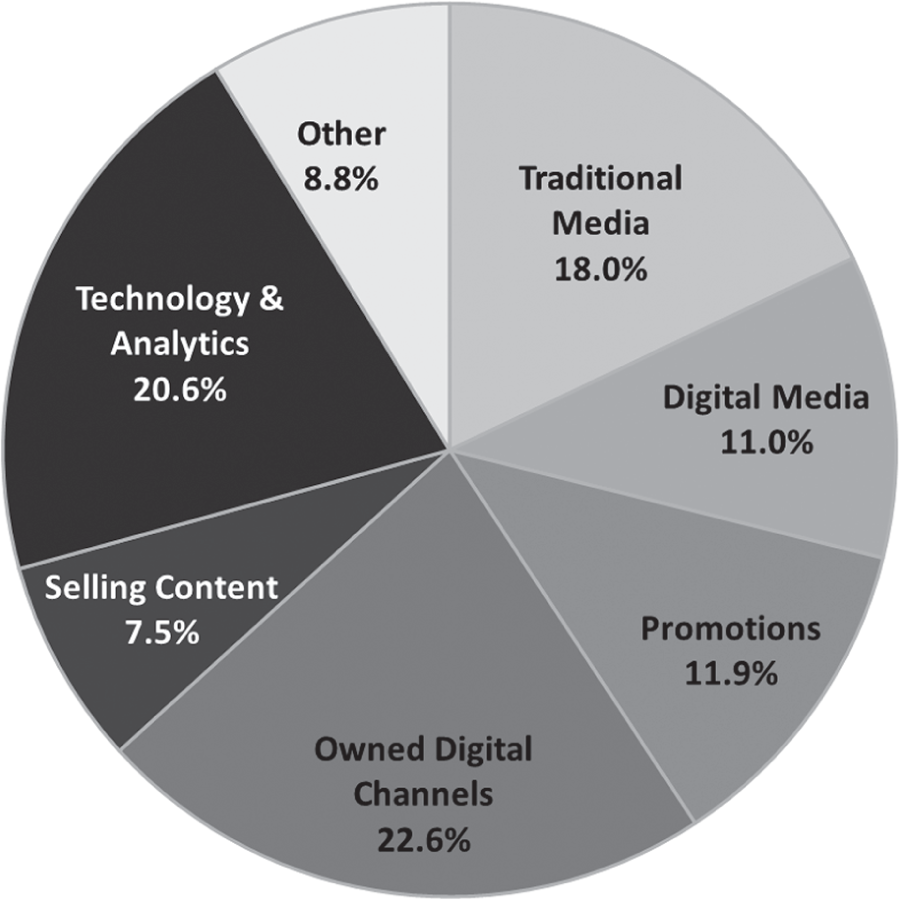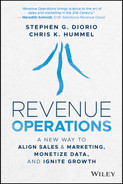CHAPTER 6
Assemble the Nine Building Blocks of Revenue Operations
In Part I of this book, we established that organic growth is the primary driver of firm value. That growth formula keeps changing, however, as buyer behavior changes, as digital technology becomes critical to selling, and as our organizations deal with the fragmentation of growth functions. To solve these challenges, companies need to balance the art and science of growth by adopting a systems-based commercial model. That model is Revenue Operations.
In Part II of the book, we introduced a management system for aligning your revenue teams. That management system has six specific pillars that embed several core leadership principles. Based on our research and interviews, we presented three alternatives on how to structure the leadership and operations of your revenue teams.
In this section of the book, we introduce the second component system of Revenue Operations, an operating system. This operating system combines technology, data, processes, and teams to help you generate consistent and scalable growth.
Consistency may be boring, but it represents a manageable path to value creation. Businesses like Toyota and GE created hundreds of billions of dollars of firm value by applying continuous process improvement to their operations and supply chains. For this they used principles like Lean Manufacturing, Kaizen, Six Sigma, And Total Quality Management. Why not take a similar approach to the customer-facing part of the business? Consistent, repeatable revenue growth earns a lot of benefits: sellers execute the assigned selling motion and playbook better; programs generate predictable outcomes; analytics make more accurate predictions about who to call and what to do; and more sellers make quota.
Scalability is even more attractive to investors. Digital technology – especially advanced analytics and AI – offers enormous potential to improve the productivity, engagement, speed, and visibility of sales teams. At their best, data, infrastructure, and processes interact within a technology ecosystem to accelerate sales growth, multiply the return on selling assets, and increase firm value. Although sales and marketing technology investments may have generated returns in narrow or isolated situations, the technology has rarely fulfilled anything close to its immense promise.
This operating system creates value in three ways: revenue expansion, cost reduction, and improved customer experience. Individual actions can realize continuous improvements in revenue, cost, or customer experience. If you find ways to improve two of those elements at the same time, that's what the late Professor Sumantra Ghoshal would call radical business performance improvement in his book Radical Change.107
How about delivering all three at once? That used to be considered impossible. But it's not! Building on our research and conversations with so many CXOs, targeting improvements in all three areas simultaneously is not only possible but also essential. Such transformation can only happen by adopting a systems-based approach. That's Revenue Operations. Whether you want small wins, big wins, or even commercial transformation, it offers the best path to get there.
What Does an Operating System for Business Look Like?
Connected data, technology, automation, and processes serve as a bridge between the nine building blocks that make up the foundation of the operating system that enables Revenue Operations to take hold. To make this less of a mouthful, we simply call this the Revenue Operating System (ROS) Technology infrastructure. At its heart, the Revenue Operating System uses commercial insights to connect your growth assets and value drivers in ways that generate growth and create firm value (see Figure 6.1).
Growth assets include the physical and increasingly important intangible assets you use to acquire, develop, and expand customer relationships. People, data, technology, brand preference, selling methods, customer relationship equity, channels, and mindshare represent just a few of these. The people in your marketing, sales, and service teams are often the biggest resource in the selling system, though the shift to digital channels and selling infrastructure have made selling more capital intensive. Over 90% of the CEOs and leaders we spoke with told us, in one way or another, that “our people are our biggest growth assets.” Collectively, these growth assets represent large financial investments in your business with an operating budget that generally ranges from 15 to 50% of overall revenues, depending on company size and scale.

FIGURE 6.1 The Revenue Operating System: Introduction
Commercial insights inform actions, conversations, and decisions. To us, commercial insights are the intelligence that informs management decisions, selling actions, and resource allocation. Not data alone. Insights act as the mechanism that allows you to connect your growth assets to the value drivers. Advanced analytics delivers intelligence about customer demand, buyer preference, opportunities, seller productivity, and customer response. Intelligence about seller skills, activities, and performance improves skill training, content, resource allocation, and effectiveness. Using top-down and bottom-up insights, leaders gain visibility into account health, pipeline health, seller performance, and dynamic changes in the market.
Value drivers are capabilities that generate more revenue and margins from your teams and resources. Talent management, innovation, pricing, promotions, and process automation help optimally allocate resources against opportunities, maximize the yield from every selling interaction, and unlock the full potential of your selling talent. For example, B2B selling organizations can get higher engagement, speed of response, and productivity from their sales reps at lower costs by migrating more customer interactions to low-touch digital channels and by using enabling technologies to enhance the value of personal interactions.
Most organizations have historically managed their growth assets and capabilities in fragmented and tactical ways. For example, three decades after the advent of CRM, 67% of enterprise CRM implementations still generate lower than acceptable return on investment, less than satisfactory user adoption, and an unfortunate amount of unrealized potential, according to research by the Sales Management Association.2
To be clear, the problem is not CRM technology. Salesforce.com is integrated into most of the leading sales enablement, engagement, and analytics tools in our list of the top 100 technologies that are transforming the commercial model.25 The failure to make CRM part of a simplified seller workflow and system of record for all customer engagement data, however, is the problem. It's a systems problem – not a technology problem.
The Building Blocks of the Revenue Operating System
According to our research, the Revenue Operating System can be broken down into nine discrete building blocks. Three growth assets include the selling technology stack, the customer-facing technology stack, and the channels your organization uses to engage and sell to customers. Commercial insights include data around customer engagement, data around seller behavior, and an advanced analytics hub that consolidates and examines all revenue-related data for patterns, insights, and triggers. Three value drivers also identify the capabilities to find and develop talent, optimally deploy resources, and deliver revenue enhancements like pricing, packaging, and promotions.
Here is a list of the nine elements (see Figure 6.2):
- Revenue Enablement: The commercial technology assets, capabilities, and systems that support sellers. These include CRM and sales enablement, engagement, content management, and readiness systems. Also, they encompass a wide range of specialized tools and solutions that support the day-to-day selling workflow.

FIGURE 6.2 The Revenue Operating System: Building Blocks
- Channel Optimization: The systems, processes, and capabilities that improve the engagement, productivity, cadence, intersection, and coverage of selling channels – both digital and analog (human).
- Customer-Facing Technology: Your “owned” digital selling infrastructure, including websites, blogs, mobile apps, and e-commerce platforms. It also includes your marketing automation, contactless selling, and social media solutions you use to attract and engage customers digitally.
- Revenue Intelligence: The analytics and information technologies that extract insights from your selling and transaction data sources to help growth leaders manage and measure the financial return on growth strategies, investments, and programs. Such intelligence includes measurements, dashboards, and analytic capabilities that your organization uses to assess the financial return on growth strategies, investments, and programs.
- Engagement Data Hub: The technology and capabilities that aggregate, transform, and monetize all customer, revenue, and seller activity data from first-party systems and third-party data sources.
- Customer Intelligence: The software applications, capabilities, and processes that convert customer data into actionable insights and help customer-facing teams to make better decisions, optimize campaigns, recommend actions, answer questions, and set selling priorities.
- Talent Development: All the technology, processes, assets, and capabilities that you use to attract, develop, and retain selling talent across all functions. This includes training methodologies, selling playbooks, learning management systems, sales readiness and development software, and learning and development programs.
- Resource Optimization: The technology, processes, and capabilities your organization uses to optimally allocate people, time, and effort against customers and markets. It includes applications and analytics that help you define territories, set quotas, prioritize accounts, and direct demand management activities.
- Revenue Enhancement: The technology and processes that help sellers generate more margin, revenue, and value in their interactions with customers. These include tools, capabilities, and solutions that help optimize and enforce pricing, personalize offerings, and create more effective presentations and proposals.
Every organization must develop each of these building blocks, even if the deployment and execution vary slightly with the competitive differentiation of every company. Some will involve tangible software platforms and organizations, such as CRM or a sales enablement function. Others will be “intangible” elements that exist between the ears of your team members as belief systems, selling expertise, or operating assumptions. For example, most territory and quota plans allocate resources based on historical performance data and institutional predispositions that are not documented, widely shared, or periodically retested against dynamic market conditions.130
These nine building blocks are universal to any modern selling system. Managers from different organizations, perspectives, and backgrounds can understand them. Importantly, the standardization of the nomenclature provides a common vocabulary that allows different players to identify, agree upon, and communicate around collaborative efforts that accelerate revenue growth, reduce costs, and improve the customer experience.
These building blocks serve as centers of gravity within your organization without taking away what makes you who you are. Historical organizational structures and legacy technology investments can certainly create barriers to growth, but the operating system here creates a resilience and an always-on focus that most businesses don't have.
The Team That Connects the Most Dots Wins
Revenue Operations requires real alignment and integration across traditionally compartmentalized divisions of your revenue team to be successful. This operating system looks for ways you can use insights to connect all the pieces in meaningful, differentiated, and value-creating ways.
The team that connects the most dots wins.
Finding the connective tissue between building blocks amplifies results and creates inherent value from better channel performance, optimized resource allocation, more effective offerings, and of course, more engaged employees.
Here are some of the top ways the executives we interviewed connect the dots to create value:
- Eliminate margin, price, and opportunity leakage by getting greater control over the entire revenue cycle (demand, transaction, and consumption).
- Increase the speed, visibility, and performance of your customer-facing employees by simplifying day-to-day seller interactions.
- Turn your technology into a force multiplier that increases your return on growth assets, resources, and investments.
- Attract, recruit, ramp up, and retain higher-performing sales talent that stays at your company longer.
- Balance resource allocation to support more quota-achieving sales reps and capture more market opportunities.
Business leaders need to connect the dots across an increasingly large and complex technology ecosystem to generate more consistent and scalable growth. The choices for sales infrastructure and customer-facing technology solutions has exploded the range of point solutions, customer touch points, and data sources that we all have to sort out. “Marketers are dealing with an exploding possibility curve in terms of channels, investments, choices and change—it's difficult to set priorities when there are so many smart things to pursue,” says David Edelman, former CMO of Aetna. In the past 20 years, this portfolio of technology investments now occupies a significant portion of the sales and marketing mix and balance sheet. Owned digital infrastructure and resources (i.e. content, data scientists, bloggers, and promotions) arguably fill two-thirds of the marketing mix, for example, according to an analysis by the Marketing Accountability Standards Board.1 (See Figure 6.3.) Yet these critical growth assets are still managed tactically and in silos.
No single tool will solve every problem. It takes many steps to collect, transform, and deploy information from one source to the person or place where it can create value. Getting effective sales content to sellers at the moment they need it, for example, takes at least three steps and spans many systems. Data about customers is the same. Capturing, aggregating, analyzing, and deploying insights based on customer interaction data is also a multistep journey.

FIGURE 6.3 The Modern Growth Investment Mix. Source: The Marketing Accountability Standards Board
Historically, technology vendors would constantly redefine market categories in smaller and smaller terms to find a space where they could defensibly claim a #1 leadership position. A whole industry of analysts has grown up that reinforces this notion with an ever-expanding array of “magic quadrants” and vendor analyses that narrowly define solutions into smaller and tighter market segments. Where a technology provider exists in multiple categories, it too often has to prove its worth as a “platform” or be punished as disjointed and confusing.
Now, rethink this through the lens of the Revenue Operating System, and you'll find leading providers of revenue enablement solutions like Revenue.io, Highspot, 6sense, RFPIO, and Varicent span three or more established technology categories. These providers defy conventional categorization because they've found a better way. They assert that connecting the dots across multiple technology ecosystems is a good thing. In fact, every solution included on our rankings of the top 100 technologies that are transforming the commercial model connect at least three of the nine building blocks.25 They don't see this integration as excess; rather, they promote the connection as a core tenet of their solution's value.
Robert Wahbe, CEO and Co-Founder of Highspot, a platform dedicated to connecting the sales and marketing technologies into more coherent selling workflows, reiterates the importance of having an “operating system” that supports sellers better. “There are thousands of technologies that can improve the performance of revenue teams in terms of generating more consistent revenue attainment, improving the customer experience and selling more value,” says Wahbe.71 “Organizations have invested in 20 on average. Some have 10. Some 40. What's important is not the number of tools, but your ability to connect the dots across the sales and marketing technology ecosystem. This looks complex. And from a product integration and data flow perspective it is. That's where we invest most of our money.”
Viral Bajaria, the CTO and Founder of 6sense, reinforces the notion of connecting the commercial technology portfolio into an operating system for growth. He thinks about the sales and marketing technology ecosystem as a periodic table of elements that can help you grow. “You need a holistic system like this because that is how you improve the customer experience, create value and margin, and grow,” he says.70 “You need to orchestrate across the different silos of technology. That's how value gets created in modern selling.”
Successful growth leaders like Juniper Networks and Hitachi are using an operating system structure to break down silos of automation and reconnect their sales and marketing technology ecosystems.
“Connecting these dots may sound complicated, but it doesn't have to be,” says Jeff McKittrick of WalkMe, who has also led sales enablement at Cisco and Hitachi. “One thing I've learned in 15 years of building and implementing digital selling and sales enablement platforms at Cisco, Hitachi and now WalkMe is that when it comes to technology people tend to overthink things. In reality, knitting together a highly profitable and productive portfolio of selling technologies is not rocket science. It does require hard work, teamwork, and leadership. But there's definitely a cookbook – and the recipe for success is pretty straightforward.”
Marcus Jewell, CRO of Juniper Networks, suggests that “the technology tools are useful, but they are really just ingredients to an operating system for growth. The real value,” according to Jewell, “is in connecting the dots.”116 Jewell believes that leaders should be orchestrators of different technologies that augment seller activities and customer interactions in a manner consistent with your organization's uniqueness. “Every organization has its own unique ‘operating system’ for selling,” Jewell continues. “So, it's a fallacy to think that there's going to be one platform to fit them all. And why would you abdicate such a strategic asset to an outside one size fits all tool?”
Mike Marcellin, CMO of Juniper Networks, adds: “It's particularly important to connect the dots between sales and marketing because selling is not a linear process. Both sales and marketing operations both have assets that can enable the complete revenue cycle. Sales may dip in and do some things. Marketing may engage in other parts of the revenue cycle. If one doesn't know what the other is doing you've lost, and the customer has a horrible experience.”
Maximize and interconnect your building blocks to create significant growth upside because the current approach likely isn't working. Twenty-five years after the dawn of e-commerce, less than 25% of B2B sales are delivered through digital channels, despite a recent bump from the pandemic. A decade into the era of big data, the impact of analytics on decision-making and firm financial performance remains basically flat, according to research by the Duke Fuqua School of Business.4 Sales leaders and practitioners are not leveraging the data they have to improve seller effectiveness or discern buyer intent. Adoption rates of other highly touted and ready-to-deploy technologies – 5G communications, augmented reality, and AI – remain less than 10%.13 Like most selling initiatives, these technologies require effective leadership commitment and change management to realize their potential.
Ultimately, Revenue Operations will manifest itself in a complete rethinking of the full commercial technology stack (meaning all of your sales and marketing technology). The new generation of leaders distinguish themselves by how they get technologies to work together. For them, the building blocks weave together in technology ecosystems that generate higher returns on their selling assets and grow sales, profit, and firm value.
In the next several chapters, we will break down the nine building blocks of the Revenue Operating System into their component parts (see Figure 6.4). We define each of these for clarity in the glossary at the end of the book.

FIGURE 6.4 The Revenue Operating System
